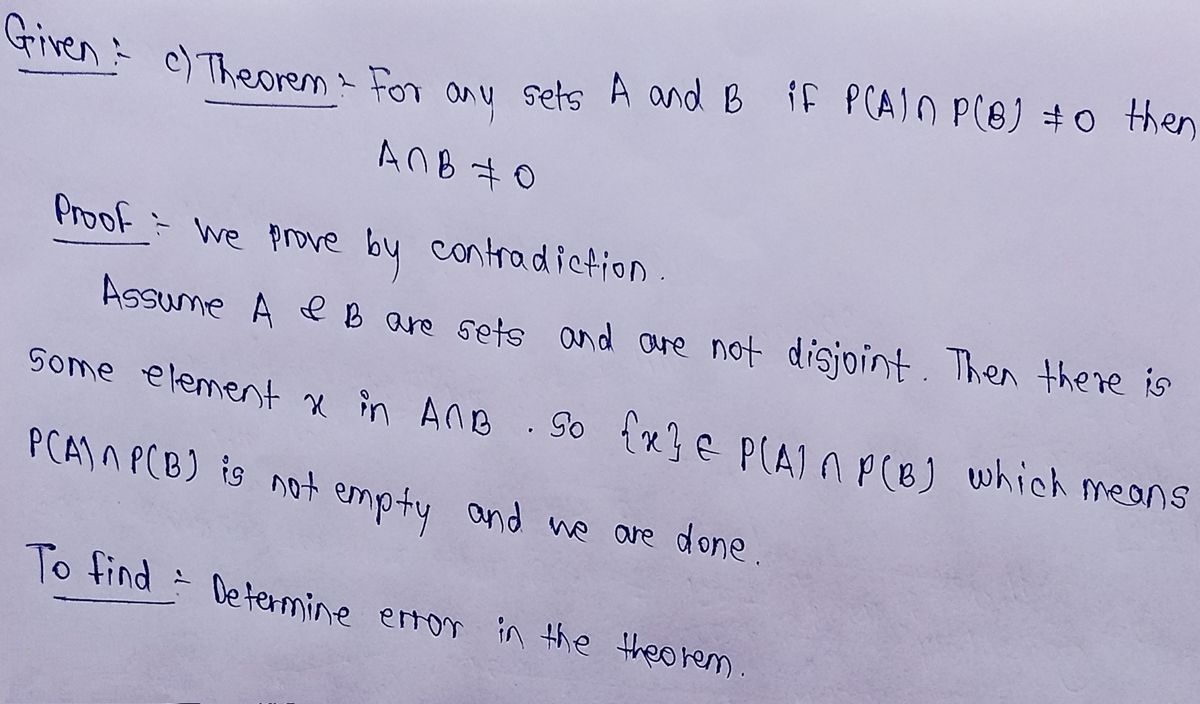PROOF EVALUATION (This type of exercise will appear occasionally): Each of the follow- ing a proposed "proof" of a "theorem". However the "theorem" may not be a true statement, and even if it is, the "proof" may not really be a proof. You should read each "theorem" and "proof" carefully and decide and state whether or not the "theorem" is true. Then: • If the "theorem" is false, find where the "proof" fails. (There has to be some error.) • If the "theorem" is true, decide and state whether or not the "proof" is correct. If it is not correct, find where the "proof" fails.
PROOF EVALUATION (This type of exercise will appear occasionally): Each of the follow- ing a proposed "proof" of a "theorem". However the "theorem" may not be a true statement, and even if it is, the "proof" may not really be a proof. You should read each "theorem" and "proof" carefully and decide and state whether or not the "theorem" is true. Then: • If the "theorem" is false, find where the "proof" fails. (There has to be some error.) • If the "theorem" is true, decide and state whether or not the "proof" is correct. If it is not correct, find where the "proof" fails.
Advanced Engineering Mathematics
10th Edition
ISBN:9780470458365
Author:Erwin Kreyszig
Publisher:Erwin Kreyszig
Chapter2: Second-order Linear Odes
Section: Chapter Questions
Problem 1RQ
Related questions
Question

Transcribed Image Text:**Proof Evaluation**
(This type of exercise will appear occasionally.)
Each of the following is a proposed "proof" of a "theorem". However, the "theorem" may not be a true statement, and even if it is, the "proof" may not really be a proof. You should read each "theorem" and "proof" carefully and decide and state whether or not the "theorem" is true. Then:
- If the "theorem" is false, find where the "proof" fails. (There has to be some error.)
- If the "theorem" is true, decide and state whether or not the "proof" is correct. If it is not correct, find where the "proof" fails.

Transcribed Image Text:**Theorem:**
For any sets \( A \) and \( B \), if \( \mathcal{P}(A) \cap \mathcal{P}(B) \neq \emptyset \), then \( A \cap B \neq \emptyset \).
**Proof:**
We will prove this by contradiction. Assume \( A \) and \( B \) are sets, and to get a contradiction, assume \( A \) and \( B \) are *not* disjoint. Then there is some element \( x \) in \( A \cap B \). So \( \{x\} \in \mathcal{P}(A) \cap \mathcal{P}(B) \), which means that \( \mathcal{P}(A) \cap \mathcal{P}(B) \) is not empty, and we are done.
Expert Solution
Step 1

Step by step
Solved in 2 steps with 2 images

Recommended textbooks for you

Advanced Engineering Mathematics
Advanced Math
ISBN:
9780470458365
Author:
Erwin Kreyszig
Publisher:
Wiley, John & Sons, Incorporated

Numerical Methods for Engineers
Advanced Math
ISBN:
9780073397924
Author:
Steven C. Chapra Dr., Raymond P. Canale
Publisher:
McGraw-Hill Education

Introductory Mathematics for Engineering Applicat…
Advanced Math
ISBN:
9781118141809
Author:
Nathan Klingbeil
Publisher:
WILEY

Advanced Engineering Mathematics
Advanced Math
ISBN:
9780470458365
Author:
Erwin Kreyszig
Publisher:
Wiley, John & Sons, Incorporated

Numerical Methods for Engineers
Advanced Math
ISBN:
9780073397924
Author:
Steven C. Chapra Dr., Raymond P. Canale
Publisher:
McGraw-Hill Education

Introductory Mathematics for Engineering Applicat…
Advanced Math
ISBN:
9781118141809
Author:
Nathan Klingbeil
Publisher:
WILEY

Mathematics For Machine Technology
Advanced Math
ISBN:
9781337798310
Author:
Peterson, John.
Publisher:
Cengage Learning,

